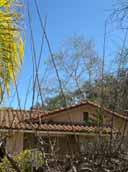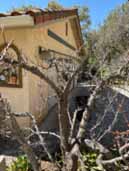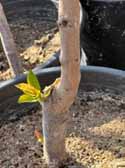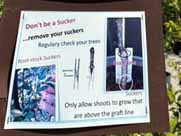Newsletter Articles
Waterspouts and Suckers on Fruit Trees
By Richard Flowers, ACCNP-Green Thumb Nursery-Ventura
It’s Spring! I went out to my garden and was analyzing my Santa Rosa Plum. They were loaded with flower buds and as a matter of fact, some are starting to show their glory of white flowers and in a few months plums will be ready to harvest. I noticed their was an abundance of vigorously growing shoots growing straight up several feet. These shoots grew differently than the shorter, more stubby growth that is characterized of flower buds. These shoots are called water sprouts and they need to be removed as they take away energy from flower and fruit production and makes the tree look un attractive by altering its shape. Water sprouts are very fast growing, nearly perfect straight stems and usually perpendicular to the ground. Most home gardeners who have Plums, Apricots, Apples, Peaches, and Nectarines are familiar with this phenomena that always occurs annually but many do not realize that it is one of the most important and basic care routine practices with almost any fruit tree which is to remove water sprouts and suckers anytime you see them. Water sprouts and suckers steal nutrients form your tree thus making the leaves turn yellow and the fruit or flowers to be scarce or poor quality. By removing both these type of growths it allows more energy to be focused toward flower and fruit production. Root sucker/water sprout growth can also occur on any fruit tree during certain anomalies such as mechanical injury, excessive water, rainy periods, drought, soil compaction, high nitrogen fertilizers, just being a fruit tree, stress, trauma, or damage to the soil or trunk area. Root sucker and water sprout growth looks un sightly, can harbor insects/disease, takes away sunlight and air circulation from the trees interior which affect the overall health of the plant and fruit quality which can lead to pest and disease issues, this is why it is imperative to remove them sooner rather than later. For newly planted tress during the first year removing water sprouts and sucker growth helps the tree become established faster because by removing this type of growth you are diverting the energy from the adventitious growth to root growth and that is what the plant needs to get established. If you leave the water sprouts on the tree, it will be less vigorous in growth.
In these photos, notice the short, stubby growth and the flower buds/ flower developing. These buds will eventually turn into fruit. This is desirable growth and should not be pruned off.
Water sprout suckers
Notice all the tall, vertical growth, growing straight up, these are called water sprouts. Water sprouts are not considered fruit producing wood. These long and gangly water sprouts produce few if any flower/ fruit. If fruit does produce on it, the weak and spindly growth may not support the load and the branch may end up breaking and damaging the tree. This weak and vertical growth is more susceptible to wind damage and breaking, causing injury to the tree.
A water sprout is an above ground sucker and is recognized by excessive amount of growth in comparison to the rest of the branch. Water sprouts occurring form the main scaffold branches are weak and will not develop into quality fruit producing wood.
Notice the difference, all the water sprouts are pruned off. The tree is now at a more manageable size, it not as tall and gangly looking as it looked before, you can actually see the main scaffolding branches. More energy will be going towards fruit and flower production instead of fast, weak, vertical growth. In a month or two, the water sprouts will need to be pruned off again. This is also known as summer pruning. This whole process is aimed toward making the tree a more manageable size, making the tree more vigorous , healthy, and to increase flower and fruit production.
Like pruning for suckers, remove water sprouts flush with the limb they’re growing on. Prune perpendicularly (45 degree angle) where the branch originates from with clean, sharp pruners. Being careful not to cut into the collar or into the bark of the tree. On thicker growth it, may be necessary to use loppers or a saw.
Trunk sucker- arrow pointing to the graft
A sucker is a rapid growing shoot that comes from below the ground or just below the graft union.The growth oftentimes looks different than the rest of the tree. Growth originating on the trunk or at the graft line should be removed as soon as they appear by cutting them off. To remove this type of sucker, if it is young and tender ( shown here), take your thumb and forefinger and simply pinch it off every time you you see it. If the sucker is older use a good, sharp, and clean pruner and cut it out.
Trunk/ basal root suckers- appearing from the soil young tender growth.
Any sucker growth that appears below the graft or bud union should always be removed. The graft is the portion of the tree that is the joining part of the rootstock (below ground portion ) and the scion (the above ground portion). The graft is usually recognized by a knob or something similar near the bottom of the tree above the soil. Growth should never occur from below this point. Sucker growth usually occurs around the base of the tree or further out. If the growth is originating from the soil you can remove very young tender ones by pulling them out of the ground. If growth is older, you will need to dig it out carefully taking care not to damage the trunk. If the growth is very old, thick, and arising away form the trunk but still close to the base of the tree you need to be persistent and cut it away/dig them out.
There are a number of reasons why you should remove sucker growth that originates below the graft. You never want rootstock growth, this type of growth will take away energy form your fruit tree by making the main tree grow slower, be less vigorous, produce less fruit because all the energy is focused on the fast growing sucker growth and not the main tree. If rootstock growth is left unchecked, it can eventually kill your tree and you will be left with undesirable fruit and growth. In other words, if you have a Santa Rosa Plum and root stock sucker took over the fruit that comes on will not be a Santa Rosa Plum, instead it might be a bad tasing peach.
There are a couple select fruit tree rootstocks for apples and cherries only that are noted to produce few or little sucker growth (trunk/ basal root suckers). Namely they are Geneva 969 for Apple (semi dwarf) and Maxima 14 for Cherry (semi dwarf). Some of the apple and cherry varieties sold at your favorite Green Thumb Nursery form Dave Wilson Nursery are labeled with a root stock description tag attached to the trees.
Here are some tips to help prevent the growth of suckers and water sprouts. When planting a new tree only plant as deep as they are in the nursery container. If they are bare root, never bury the graft, have the graft above the soil line or look for a change in bark texture between the upper trunk and the roots. Do not over water. Use a slow release fertilizer instead of a fast release fertilizer to help promote the plants immune system and not get a fast surge of growth. When pruning never prune more that 1/3 off your plant and avoid lolly-popping( topping or pruning it round). When mulching avoid piling mulch up around the trunk of the tree, instead apply a 3-4 inch layer of mulch material under the canopy (drip line) of the plant and directly under the branches not touching the trunk.
You may want to consider using any of these two products to help in the aide of removing water sprout suckers and trunk/ basal root suckers on a limited selection of fruit trees. Please note: These products are to be used only on Apples, Pears, Olives, non bearing( not in fruit) citrus, and some ornamentals only. Please read, follow, and understand label directions carefully as it has specific use requirements. Other fruit trees not listed on the label or the timing have lapsed need to be dealt with manually.
I hope you find this information useful. Head on over to your favorite Green Thumb Nursery, we are here for all your gardening needs.
Do you like what you see? Sign up for our weekly newsletter to get content like this every week!











